Gas compressor A gas compressor is a
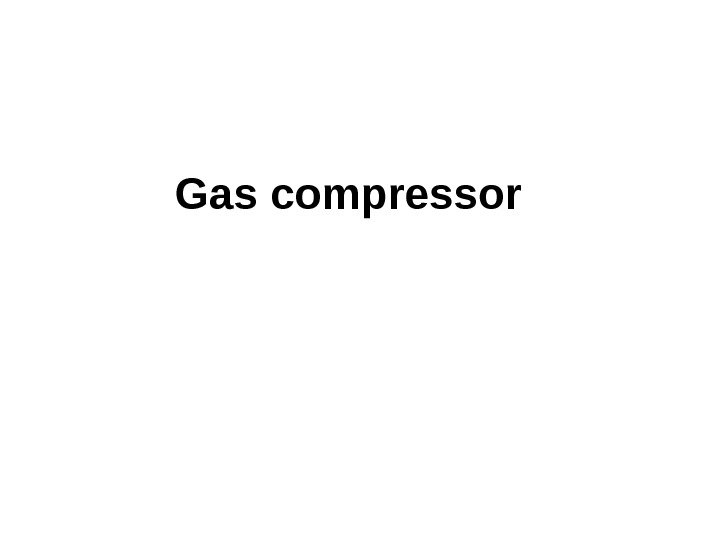

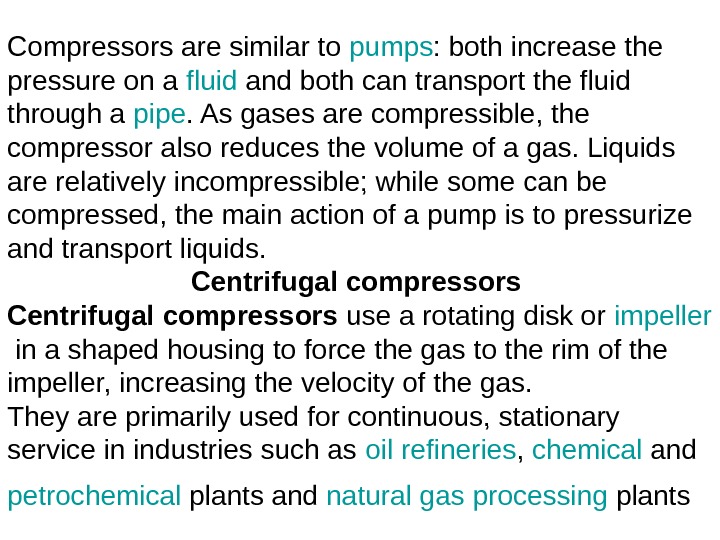
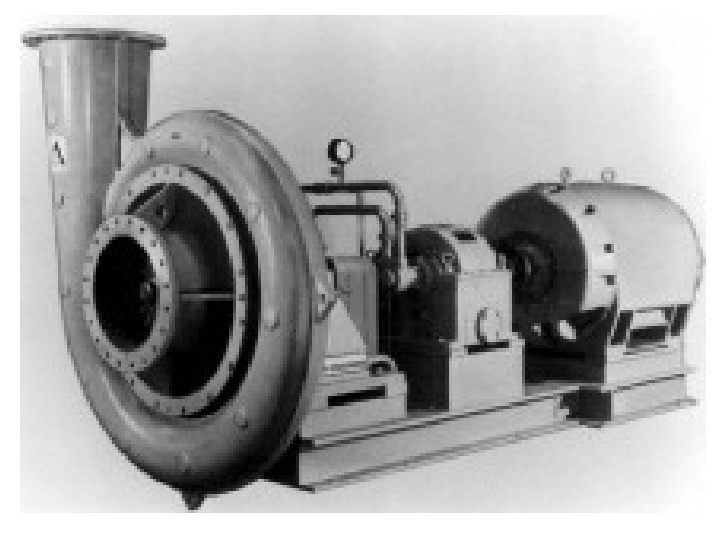
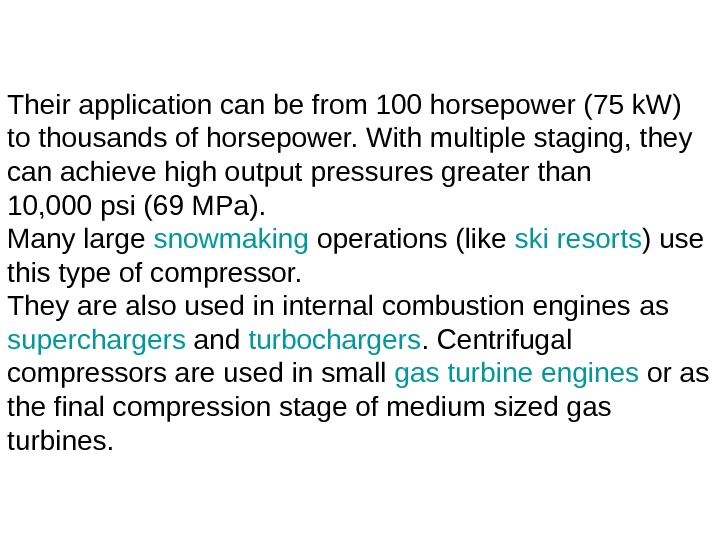
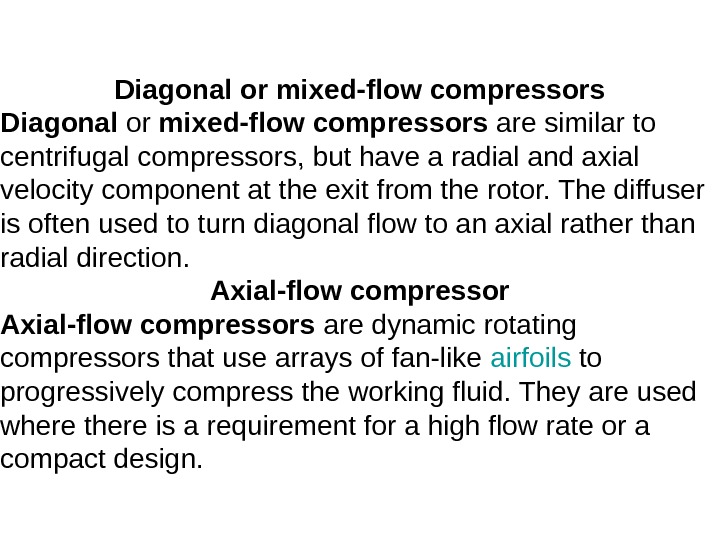

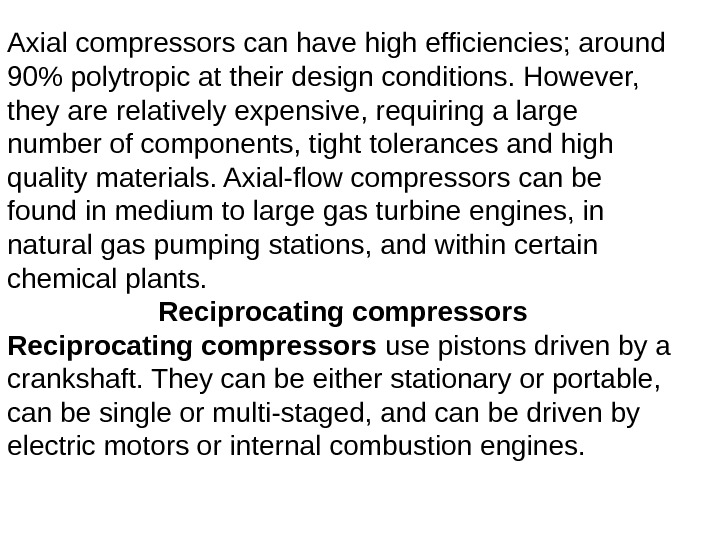
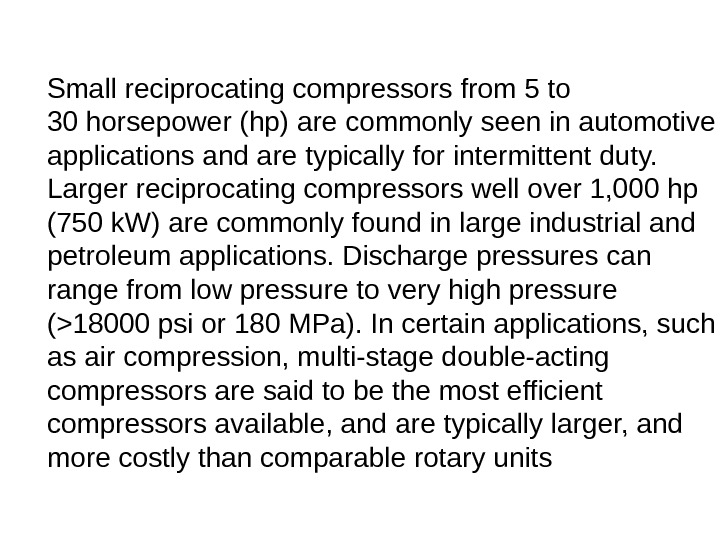

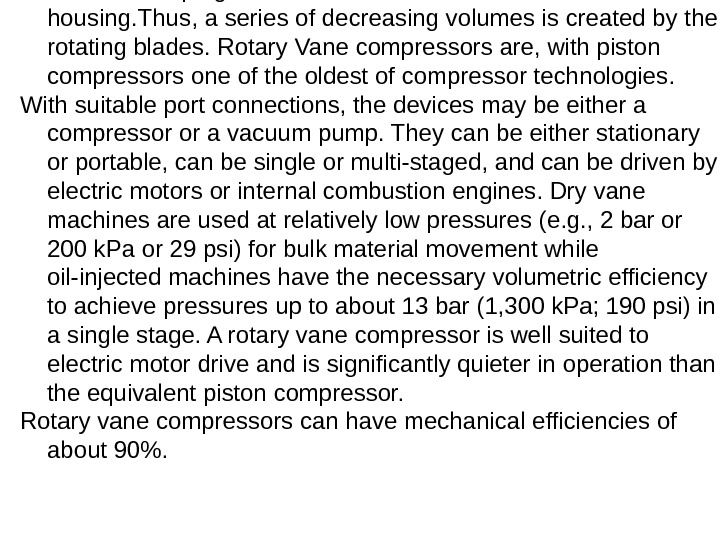

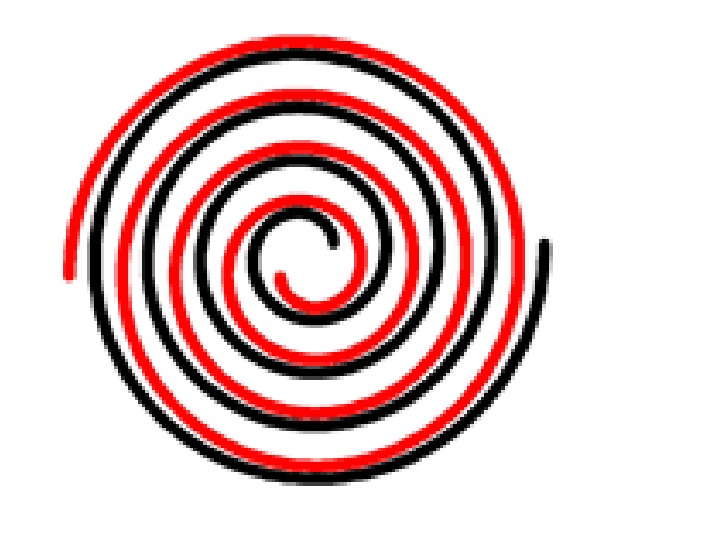
- Размер: 601.5 Кб
- Количество слайдов: 13
Описание презентации Gas compressor A gas compressor is a по слайдам
 Gas compressor
Gas compressor
 A gas compressor is a mechanical device that increases the pressure of a gas by reducing its volume. An air compressor is a specific type of gas compressor. An air compressor is a device that converts power (usually from an electric motor, a diesel engine or a gasoline engine) into potential energy by forcing air into a smaller volume and thus increasing its pressure. The energy in the compressed air can be stored while the air remains pressurized. The energy can be used for a variety of applications, usually by utilizing the kinetic energy of the air as it is depressurized.
A gas compressor is a mechanical device that increases the pressure of a gas by reducing its volume. An air compressor is a specific type of gas compressor. An air compressor is a device that converts power (usually from an electric motor, a diesel engine or a gasoline engine) into potential energy by forcing air into a smaller volume and thus increasing its pressure. The energy in the compressed air can be stored while the air remains pressurized. The energy can be used for a variety of applications, usually by utilizing the kinetic energy of the air as it is depressurized.
 Compressors are similar to pumps : both increase the pressure on a fluid and both can transport the fluid through a pipe. As gases are compressible, the compressor also reduces the volume of a gas. Liquids are relatively incompressible; while some can be compressed, the main action of a pump is to pressurize and transport liquids. Centrifugal compressors use a rotating disk or impeller in a shaped housing to force the gas to the rim of the impeller, increasing the velocity of the gas. They are primarily used for continuous, stationary service in industries such as oil refineries , chemical and petrochemical plants and natural gas processing plants
Compressors are similar to pumps : both increase the pressure on a fluid and both can transport the fluid through a pipe. As gases are compressible, the compressor also reduces the volume of a gas. Liquids are relatively incompressible; while some can be compressed, the main action of a pump is to pressurize and transport liquids. Centrifugal compressors use a rotating disk or impeller in a shaped housing to force the gas to the rim of the impeller, increasing the velocity of the gas. They are primarily used for continuous, stationary service in industries such as oil refineries , chemical and petrochemical plants and natural gas processing plants

 Their application can be from 100 horsepower (75 k. W) to thousands of horsepower. With multiple staging, they can achieve high output pressures greater than 10, 000 psi (69 MPa). Many large snowmaking operations (like ski resorts ) use this type of compressor. They are also used in internal combustion engines as superchargers and turbochargers. Centrifugal compressors are used in small gas turbine engines or as the final compression stage of medium sized gas turbines.
Their application can be from 100 horsepower (75 k. W) to thousands of horsepower. With multiple staging, they can achieve high output pressures greater than 10, 000 psi (69 MPa). Many large snowmaking operations (like ski resorts ) use this type of compressor. They are also used in internal combustion engines as superchargers and turbochargers. Centrifugal compressors are used in small gas turbine engines or as the final compression stage of medium sized gas turbines.
 Diagonal or mixed-flow compressors are similar to centrifugal compressors, but have a radial and axial velocity component at the exit from the rotor. The diffuser is often used to turn diagonal flow to an axial rather than radial direction. Axial-flow compressors are dynamic rotating compressors that use arrays of fan-like airfoils to progressively compress the working fluid. They are used where there is a requirement for a high flow rate or a compact design.
Diagonal or mixed-flow compressors are similar to centrifugal compressors, but have a radial and axial velocity component at the exit from the rotor. The diffuser is often used to turn diagonal flow to an axial rather than radial direction. Axial-flow compressors are dynamic rotating compressors that use arrays of fan-like airfoils to progressively compress the working fluid. They are used where there is a requirement for a high flow rate or a compact design.

 Axial compressors can have high efficiencies; around 90% polytropic at their design conditions. However, they are relatively expensive, requiring a large number of components, tight tolerances and high quality materials. Axial-flow compressors can be found in medium to large gas turbine engines, in natural gas pumping stations, and within certain chemical plants. Reciprocating compressors use pistons driven by a crankshaft. They can be either stationary or portable, can be single or multi-staged, and can be driven by electric motors or internal combustion engines.
Axial compressors can have high efficiencies; around 90% polytropic at their design conditions. However, they are relatively expensive, requiring a large number of components, tight tolerances and high quality materials. Axial-flow compressors can be found in medium to large gas turbine engines, in natural gas pumping stations, and within certain chemical plants. Reciprocating compressors use pistons driven by a crankshaft. They can be either stationary or portable, can be single or multi-staged, and can be driven by electric motors or internal combustion engines.
 Small reciprocating compressors from 5 to 30 horsepower (hp) are commonly seen in automotive applications and are typically for intermittent duty. Larger reciprocating compressors well over 1, 000 hp (750 k. W) are commonly found in large industrial and petroleum applications. Discharge pressures can range from low pressure to very high pressure (>18000 psi or 180 MPa). In certain applications, such as air compression, multi-stage double-acting compressors are said to be the most efficient compressors available, and are typically larger, and more costly than comparable rotary units
Small reciprocating compressors from 5 to 30 horsepower (hp) are commonly seen in automotive applications and are typically for intermittent duty. Larger reciprocating compressors well over 1, 000 hp (750 k. W) are commonly found in large industrial and petroleum applications. Discharge pressures can range from low pressure to very high pressure (>18000 psi or 180 MPa). In certain applications, such as air compression, multi-stage double-acting compressors are said to be the most efficient compressors available, and are typically larger, and more costly than comparable rotary units
 Rotary screw compressors use two meshed rotating positive-displacement helical screws to force the gas into a smaller space. These are usually used for continuous operation in commercial and industrial applications and may be either stationary or portable. Their application can be from 3 horsepower (2. 2 k. W) to over 1, 200 horsepower (890 k. W) and from low pressure to moderately high pressure (>1, 200 psi or 8. 3 MPa). Rotary screw compressors are commercially produced in Oil Flooded, Water Flooded and Dry type.
Rotary screw compressors use two meshed rotating positive-displacement helical screws to force the gas into a smaller space. These are usually used for continuous operation in commercial and industrial applications and may be either stationary or portable. Their application can be from 3 horsepower (2. 2 k. W) to over 1, 200 horsepower (890 k. W) and from low pressure to moderately high pressure (>1, 200 psi or 8. 3 MPa). Rotary screw compressors are commercially produced in Oil Flooded, Water Flooded and Dry type.
 Rotary vane compressors consist of a rotor with a number of blades inserted in radial slots in the rotor. The rotor is mounted offset in a larger housing that is either circular or a more complex shape. As the rotor turns, blades slide in and out of the slots keeping contact with the outer wall of the housing. Thus, a series of decreasing volumes is created by the rotating blades. Rotary Vane compressors are, with piston compressors one of the oldest of compressor technologies. With suitable port connections, the devices may be either a compressor or a vacuum pump. They can be either stationary or portable, can be single or multi-staged, and can be driven by electric motors or internal combustion engines. Dry vane machines are used at relatively low pressures (e. g. , 2 bar or 200 k. Pa or 29 psi) for bulk material movement while oil-injected machines have the necessary volumetric efficiency to achieve pressures up to about 13 bar (1, 300 k. Pa; 190 psi) in a single stage. A rotary vane compressor is well suited to electric motor drive and is significantly quieter in operation than the equivalent piston compressor. Rotary vane compressors can have mechanical efficiencies of about 90%.
Rotary vane compressors consist of a rotor with a number of blades inserted in radial slots in the rotor. The rotor is mounted offset in a larger housing that is either circular or a more complex shape. As the rotor turns, blades slide in and out of the slots keeping contact with the outer wall of the housing. Thus, a series of decreasing volumes is created by the rotating blades. Rotary Vane compressors are, with piston compressors one of the oldest of compressor technologies. With suitable port connections, the devices may be either a compressor or a vacuum pump. They can be either stationary or portable, can be single or multi-staged, and can be driven by electric motors or internal combustion engines. Dry vane machines are used at relatively low pressures (e. g. , 2 bar or 200 k. Pa or 29 psi) for bulk material movement while oil-injected machines have the necessary volumetric efficiency to achieve pressures up to about 13 bar (1, 300 k. Pa; 190 psi) in a single stage. A rotary vane compressor is well suited to electric motor drive and is significantly quieter in operation than the equivalent piston compressor. Rotary vane compressors can have mechanical efficiencies of about 90%.
 A scroll compressor, also known as scroll pump and scroll vacuum pump, uses two interleaved spiral-like vanes to pump or compress fluids such as liquids and gases. They operate more smoothly, quietly, and reliably than other types of compressors in the lower volume range. Due to minimum clearance volume between the fixed scroll and the orbiting scroll, these compressors have a very high volumetric efficiency. This type of compressor was used as the supercharger on Volkswagen G 60 and G 40 engines in the early 1990 s. Rotary vane compressors can have mechanical efficiencies of about 90%.
A scroll compressor, also known as scroll pump and scroll vacuum pump, uses two interleaved spiral-like vanes to pump or compress fluids such as liquids and gases. They operate more smoothly, quietly, and reliably than other types of compressors in the lower volume range. Due to minimum clearance volume between the fixed scroll and the orbiting scroll, these compressors have a very high volumetric efficiency. This type of compressor was used as the supercharger on Volkswagen G 60 and G 40 engines in the early 1990 s. Rotary vane compressors can have mechanical efficiencies of about 90%.

